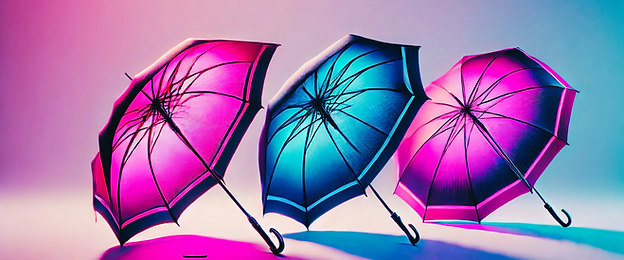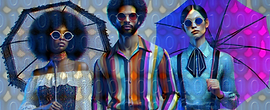
bi+ emoji project 2025
- unicode proposal summary -
Each emoji is a metadata marker, a signal that teaches digital systems what exists, who matters, and how we’re represented. Emoji are part of the universal language used by over 7 billion smartphones in texts, social media, search engines, and AI communications. Without encoded digital markers, these symbols are rootless and indecipherable even to those who may share experiences or labels.
"Bisexual/Bi+ Identity Symbol" emoji, visually rendered as a multicolored umbrella based on the bisexual pride colors (pink, purple, blue), has been proposed into the Unicode Standard. Intended for the Symbols > Other category, the emoji addresses a semantic gap in digital expression for the largest demographic within the LGBTQ+ community, bi+ users, which include pansexual, fluid, omnisexual, polysexual, unlabeled, etc.
Bi+ identities are digitally invisible, misrepresented and forced to use ad-hoc emoji combinations. Ranging from 💗💜💙to entirely unrelated symbols like 🧞♀️, 🫂, 🎟️, ⚛️8️⃣3️⃣, 👍😬👍 or 👉👉or even 🐸. Drawing from advocacy, academic literature, algorithmic research, and cultural usage patterns, this proposal presents the emoji as a symbol of digital inclusivity, safety, and cultural identity. The umbrella metaphor, rooted in academic scholarship and lived experiences, transcends orientation alone, offering visual expression for romance, community, intersectionality, and mental health signaling. This symbol is distinct, culturally durable, and aligns with Unicode’s strategic priorities of bridging global semantic gaps and enabling identity representation through visual language.
- why -



- backstory -
I grew up in 1990s Los Angeles without ever hearing the word "bisexual," not on TV, not in school, not in friend circles, not in society at large. Like so many other bi+ folks, I carried the burden of “ambiguity” well into my teens, navigating shame, silence, and stereotypes in the absence of language. And later the absence of understanding being bi was something that was possible and normal.
Even after I understood this, those early experiences of suspicion around my orientation stayed with me. Now, years later, as an artist and author working at the intersection of education, identity, and art, I realized that digital spaces have progressed and society has come a long way, but just like analog spaces I grew up in, they leave us out. The idea of “neighborhood” has shifted to screens and platforms, and accountability and moderation online is a bit more elusive to achieve. So I put on my artist hat and author hat on and got to cookin'.
As a bi+ black creator, I’m mindful of how the contributions of people like me are systemically erased, anonymized, or absorbed into collective efforts without recognition. While this proposal was shaped by tons of conversations, insights, and shared experiences, it is independently researched and authored, with the assistance of a long time editorial collaborator. Historically, both Black Americans, descendants of slaves in United States, and people who were likely bisexual have been pushed to the margins, erased from records, or retroactively claimed. This work aims to reclaim the symbolic contributions of black folks and fluid folks explicitly. The proposal is offered in the spirit of public good, and its origin, authorship, and intent should be acknowledged in all citations, coverage, or adaptations.
- design -
First, why not propose the bisexual pride flag?
In 2022, Unicode stated it no longer accepts flag proposals, including identity flags. As interest in emoji has grown, and emojis are encoded forever, the consortium relies heavily on robust empirical evidence over anecdotal, cause-based, or justice-based propositions.
That meant if we are proposing digital inclusion, design and authorship would need to exist within the Unicode standards and with their strategic goals in mind.
The proposed "Bisexual Identity Symbol" AKA bi+ umbrella emoji is:
(1) literal and metaphorical, culturally relevant,
(2) informed by academic scholarship, and
(3) technically and strategically viable to Unicode:
-
Fills a quantitative and qualitative semantic gap
-
Has potential global usage
-
Cannot be clearly captured using existing emoji
-
Is visually distinct and iconic
-
Avoids flag encoding restrictions, modifiers, and ZWJ sequences
-
Is scalable across platforms and devices in color and black and white
-
Is future proof and will not require future proposals


.png)
